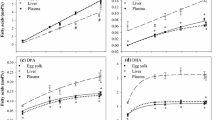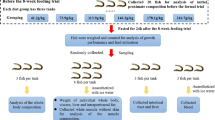Abstract
Three experiments were conducted with day-old broiler chicks reared to 18 or 19 d of age. The objective was to examine the effects of dietary oil (cottonseed oil vs fish oil), dietary antioxidant (0 vs 75 ppm ethoxyquin), and dietary lead (0 vs 1000 ppm Pb as lead acetate trihydrate) on hepatic fatty acid composition. A 2×2 factorial arrangement was used in all experiments. In Experiment 1, the factors were oil (4% of each) and Pb. In Experiments 2 and 3, the factors were ethoxyquin and Pb in diets containing 3.5% cottonseed oil (Experiment 2) or 3.5% fish oil (Experiment 3). Hepatic fatty acid profiles were measured by gas-liquid chromatography in 10 chicks/treatment (Experiment 1) or 4 chicks/treatment (Experiments 2 and 3). Dietary oils altered the profiles, with cottonseed oil producing the higher values for linoleic acid (18∶2) and arachidonic acid (20∶4). With fish oil, in addition to the lower levels of 18∶2 and 20∶4, there were significant levels of eicosapentaenoic acid (20∶5) and docosahexaenoic acid (22∶6). Pb enhanced the levels of 20∶4, but the effect was greater with cottonseed oil diets compared with fish oil diets. The enhanced 20∶4 levels resulted in lower ratios of 18∶2/20∶4. Ethoxyquin enhanced the level of 18∶2 with the cottonseed oil diet, and of 20∶5 and 22∶6 with the fish oil diet. Ethoxyquin decreased the level of hepatic 20∶4 when fish oil was fed. The results clearly show that all three factors (oil type, Pb level, and ethoxyquin level) after hepatic fatty acid composition. Both oil source and Pb level appeared to exert an effect on the metabolic conversion of 18∶2 and 20∶4. The primary effect of ethoxyquin was to enhance the levels of polyunsaturated fatty acids in liver. The data do not allow the partitioning of possible ethoxyquin effects to protection of polyunsaturated acids in feed vs protection of polyunsaturated acids in liver tissue.
Similar content being viewed by others
References
M. Sifri and W. G. Hoekstra,Fed. Proc. 37 (Abstr.), 757 (1978).
E. R. Ramstoeck, W. G. Hoekstra, and H. E. Ganther,Toxicol. Appl. Pharmacol. 73, 119–123 (1984).
O. A. Levander, V. C. Morris, and R. J. Ferretti,J. Nutr. 107, 363–372 (1977).
M. C. Cabel, P. W. Waldroup, W. D. Shermer, and D. F. Calabotta,Poultry Sci. 67, 1725–1730 (1988).
W. E. Donaldson,Biol. Trace Element Res. 31, 215–222 (1991).
J. U. Skaare and E. Solheim,Xenobiotica 9, 649–657 (1979).
W. E. Donaldson and T. K. Leeming,Toxicol. Appl. Pharmacol. 73, 119–123 (1984).
D. M. Latta and W. E. Donaldson,J. Nutr.,116, 1561–1568 (1986).
National Research Council,Nutrient Requirements of Poultry, Natl. Acad. Sci., Washington, D.C., (1984).
J. T. Helwig and K. A. Council,SAS User's Guide, Statistical Analysis System Institute, Inc., Cary, NC (1979).
R. T. Holman and H. Mohrhauer,Acta Chem. Scand. 17, Suppl. I, 884–890 (1963).
H. Mohrhauer and R. T. Holman,J. Lipid Res. 4, 151–159 (1963).
D. H. Hwang, M. Boudreau, and P. Chanmugam,J. Nutr. 118, 427–437 (1988).
W. E. Donaldson,Biol. Trace Element Res. 7, 255–262 (1985).
L. J. Lawton and W. E. Donaldson,Biol. Trace Element Res.,28, 83–97 (1991).
K. L. Fritsche and P. V. Johnston,J. Nutr. 118, 425,426 (1988).
D. Miller and V. Whife,Nutr. Rep. Int. 12, 245–254 (1975).
H. L. Kim,J. Toxicol. Environ. Health 33, 229–236 (1991).
S. Krishnamurthy and S. G. Bieri,J. Nutr. 77, 245–252 (1962).
Author information
Authors and Affiliations
Additional information
Use of trade names implies neither approval by the North Carolina Agricultural Research Service of products named nor criticism of products not named.
Rights and permissions
About this article
Cite this article
Donaldson, W.E. Effects of dietary lead, fish oil, and ethoxyquin on hepatic fatty acid composition in chicks. Biol Trace Elem Res 36, 319–326 (1993). https://doi.org/10.1007/BF02783965
Received:
Accepted:
Issue Date:
DOI: https://doi.org/10.1007/BF02783965




